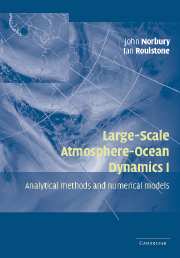Book contents
- Frontmatter
- Contents
- Contributors
- Preface
- Introduction and Scientific Background
- 1 A view of the equations of meteorological dynamics and various approximations
- 2 Extended-geostrophic Euler–Poincaré models for mesoscale oceanographic flow
- 3 Fast singular oscillating limits of stably-stratified 3D Euler and Navier–Stokes equations and ageostrophic wave fronts
- 4 New mathematical developments in atmosphere and ocean dynamics, and their application to computer simulations
- 5 Rearrangements of functions with applications to meteorology and ideal fluid flow
- 6 Statistical methods in atmospheric dynamics: probability metrics and discrepancy measures as a means of defining balance
1 - A view of the equations of meteorological dynamics and various approximations
Published online by Cambridge University Press: 04 February 2010
- Frontmatter
- Contents
- Contributors
- Preface
- Introduction and Scientific Background
- 1 A view of the equations of meteorological dynamics and various approximations
- 2 Extended-geostrophic Euler–Poincaré models for mesoscale oceanographic flow
- 3 Fast singular oscillating limits of stably-stratified 3D Euler and Navier–Stokes equations and ageostrophic wave fronts
- 4 New mathematical developments in atmosphere and ocean dynamics, and their application to computer simulations
- 5 Rearrangements of functions with applications to meteorology and ideal fluid flow
- 6 Statistical methods in atmospheric dynamics: probability metrics and discrepancy measures as a means of defining balance
Summary
Introduction
One of the attractions of meteorology is its many-faceted character. It invites study by mathematicians and statisticians as well as by physicists of either practical or theoretical disposition. Amongst other fields, its concerns border or overlap those of oceanography, geophysics, environmental science, biological science, agriculture and human physiology, and impinge on those of economics, politics and psychology. (Climatology, for present purposes, is counted as part of meteorology.) Its breadth can lead to a perception that meteorology is a ‘soft’ science. This article focuses on part of the subject's ‘hard’ core: the equations governing atmospheric flow, and the approximate forms used by many numerical modellers and theorists.
A discussion (in section 3) of the basic equations of meteorological dynamics is preceded by a glance at a pre-Newtonian but fundamental subject: fluid kinematics (section 2). Some of the conservation laws which the basic equations express or imply are examined in section 4. Subsequent sections deal with approximate versions of the basic equations. Consistent approximation is one of the mathematical challenges of meteorology, and the sheer range of possible (and permissible?) approximations can be a bewildering feature. The hydrostatic approximation, the hydrostatic primitive equations (HPEs) and the shallow water equations (SWEs) are considered in section 5. The HPEs are the basis of many of the numerical models used worldwide in weather forecasting and for climate simulation, and the SWEs are widely studied as a testbed for further approximations and for numerical schemes.
We pause in section 6 to discuss various vertical coordinate systems, and various approximations of Coriolis effects and the Earth's sphericity beyond those associated with the HPEs.
- Type
- Chapter
- Information
- Large-Scale Atmosphere-Ocean DynamicsAnalytical Methods and Numerical Models, pp. 1 - 100Publisher: Cambridge University PressPrint publication year: 2002
- 16
- Cited by



